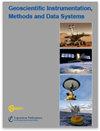用于高压水的气体平衡膜入口质谱仪(GE-MIMS)
IF 2.3
4区 地球科学
Q3 GEOSCIENCES, MULTIDISCIPLINARY
Geoscientific Instrumentation Methods and Data Systems
Pub Date : 2024-01-12
DOI:10.5194/gi-13-1-2024
引用次数: 0
摘要
摘要气体物种作为天然或人工示踪剂被广泛用于研究环境和地质系统中的流体动力学。最近开发的气体平衡膜进样质谱法(GE-MIMS)最适用于对水生系统中的溶解气体进行准确、自主的现场定量。GE-MIMS 的工作原理是将水抽过一个含有气体顶空的气体平衡器模块,该模块由气体渗透膜与水隔开。顶空气体中各种气体的分压根据亨利定律与水中的气体浓度达到平衡,并通过专为低气体消耗而优化的质谱仪(miniRUEDI 或类似仪器)进行量化。然而,常用平衡器模块的脆弱膜结构在水压≳3 巴时就会破裂。因此,这些模块不适合在深层地质系统或其他水压较高的环境中使用。为此,SysMoG® MD 膜组件(Solexperts AG,瑞士;"SOMM")被开发出来,可以承受高达 100 巴的水压。与传统的 GE-MIMS 平衡器模块相比,SOMM 模块机械结构坚固,但气体-水平衡速度慢,而且可能不完全。我们对 SOMM 的气体平衡效率进行了测试,并制定了一套经过调整的协议,使 SOMM 能够在高水压下正确运行,进行 GE-MIMS 分析。根据亨利定律,这种经过调整的 SOMM GE-MIMS 技术在维持气水平衡时,SOMM 的气体消耗量非常低,分析精度和准确度与传统的 GE-MIMS 技术相同。在地下岩石实验室进行的高压流体迁移实验中,证明了经调整的 SOMM GE-MIMS 技术的分析潜力。这项新技术克服了传统气体平衡器的压力限制,从而为在高压环境中高效、自主地现场量化溶解气体提供了新的机遇,例如在二氧化碳和废矿床地下储存的研究和监测或自然资源勘探中。本文章由计算机程序翻译,如有差异,请以英文原文为准。
Gas equilibrium membrane inlet mass spectrometry (GE-MIMS) for water at high pressure
Abstract. Gas species are widely used as natural or artificial tracers to study fluid dynamics in environmental and geological systems. The recently developed gas equilibrium membrane inlet mass spectrometry (GE-MIMS) method is most useful for accurate and autonomous on-site quantification of dissolved gases in aquatic systems. GE-MIMS works by pumping water through a gas equilibrator module containing a gas headspace, which is separated from the water by a gas-permeable membrane. The partial pressures of the gas species in the headspace equilibrate with the gas concentrations in the water according to Henry's Law and are quantified with a mass spectrometer optimized for low gas consumption (miniRUEDI or similar). However, the fragile membrane structures of the commonly used equilibrator modules break down at water pressures ≳3 bar. These modules are therefore not suitable for use in deep geological systems or other environments with high water pressures. To this end, the SysMoG® MD membrane module (Solexperts AG, Switzerland; “SOMM”) was developed to withstand water pressures of up to 100 bar. Compared to the conventionally used GE-MIMS equilibrator modules, the mechanically robust construction of the SOMM module entails slow and potentially incomplete gas–water equilibration. We tested the gas equilibration efficiency of the SOMM and developed an adapted protocol that allows correct operation of the SOMM for GE-MIMS analysis at high water pressures. This adapted SOMM GE-MIMS technique exhibits a very low gas consumption from the SOMM to maintain the gas–water equilibrium according to Henry's Law and provides the same analytical accuracy and precision as the conventional GE-MIMS technique. The analytical potential of the adapted SOMM GE-MIMS technique was demonstrated in a high-pressure fluid migration experiment in an underground rock laboratory. The new technique overcomes the pressure limitations of conventional gas equilibrators and thereby opens new opportunities for efficient and autonomous on-site quantification of dissolved gases in high-pressure environments, such as in research and monitoring of underground storage of CO2 and waste deposits or in the exploration of natural resources.
求助全文
通过发布文献求助,成功后即可免费获取论文全文。
去求助
来源期刊

Geoscientific Instrumentation Methods and Data Systems
GEOSCIENCES, MULTIDISCIPLINARYMETEOROLOGY-METEOROLOGY & ATMOSPHERIC SCIENCES
CiteScore
3.70
自引率
0.00%
发文量
23
审稿时长
37 weeks
期刊介绍:
Geoscientific Instrumentation, Methods and Data Systems (GI) is an open-access interdisciplinary electronic journal for swift publication of original articles and short communications in the area of geoscientific instruments. It covers three main areas: (i) atmospheric and geospace sciences, (ii) earth science, and (iii) ocean science. A unique feature of the journal is the emphasis on synergy between science and technology that facilitates advances in GI. These advances include but are not limited to the following:
concepts, design, and description of instrumentation and data systems;
retrieval techniques of scientific products from measurements;
calibration and data quality assessment;
uncertainty in measurements;
newly developed and planned research platforms and community instrumentation capabilities;
major national and international field campaigns and observational research programs;
new observational strategies to address societal needs in areas such as monitoring climate change and preventing natural disasters;
networking of instruments for enhancing high temporal and spatial resolution of observations.
GI has an innovative two-stage publication process involving the scientific discussion forum Geoscientific Instrumentation, Methods and Data Systems Discussions (GID), which has been designed to do the following:
foster scientific discussion;
maximize the effectiveness and transparency of scientific quality assurance;
enable rapid publication;
make scientific publications freely accessible.
 求助内容:
求助内容: 应助结果提醒方式:
应助结果提醒方式:


